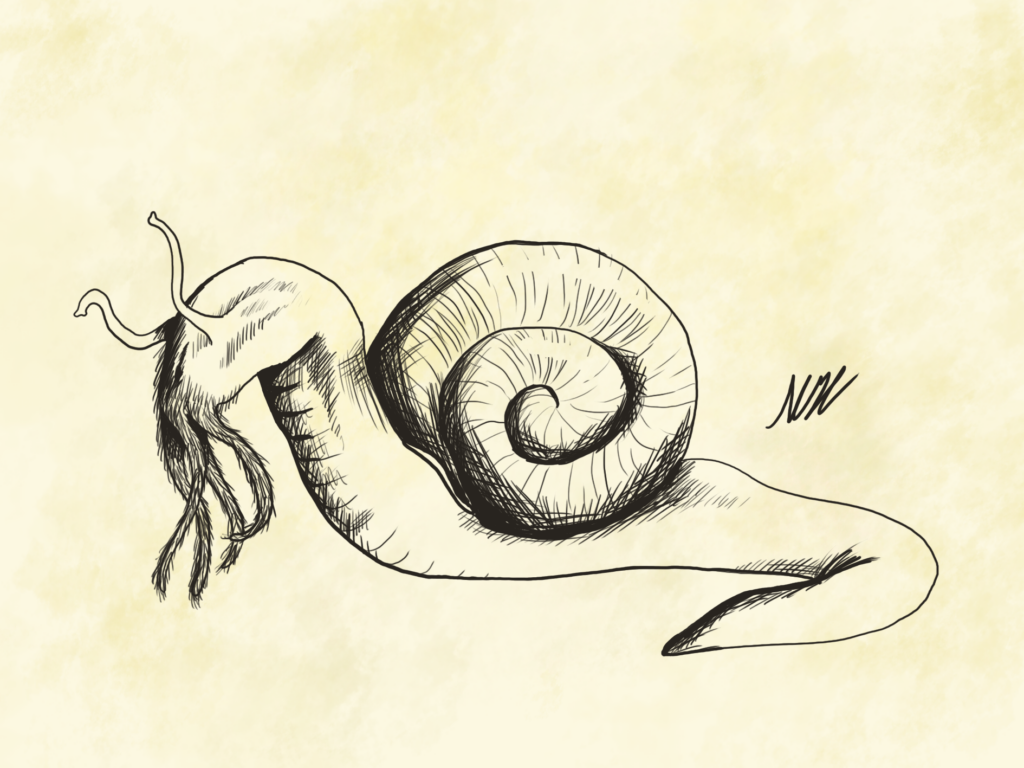Lou Carcolh is a creature from Gascon folklore, a region in southwestern France. This terrifying mythological beast is often described as a monstrous, snail-like or serpent-like creature with enormous, slimy tentacles that extend for incredible distances. Lou Carcolh is considered one of the most unusual and unsettling figures in French folklore due to its grotesque appearance and its ability to ensnare victims with its long, sticky appendages.


Description of Lou Carcolh
- Physical Form: Lou Carcolh is typically depicted as an enormous, grotesque creature that combines elements of a serpent and a giant snail. It has a large, slimy body like that of a snail, often described as having a massive shell, while its head and neck resemble a serpent or a dragon. What makes Lou Carcolh especially terrifying are its tentacles, which are long, slimy, and extend for miles, capable of reaching into towns and villages from its subterranean lair.
- Tentacles of Doom: The most infamous feature of Lou Carcolh is its tentacles. These appendages are said to be incredibly long and sticky, capable of grabbing anything that comes near. The tentacles can reach out of dark caves, forests, or underground tunnels to snatch animals and people. Once captured by the tentacles, the victims are dragged back to the creature’s lair, where they are devoured.
- Its Lair: Lou Carcolh is believed to live in the deep caverns or tunnels beneath the earth, particularly around the city of Hastingues in Gascony. Some versions of the myth say that it lives in natural caves or underground rivers, while others describe it inhabiting man-made tunnels from ancient times. The caves are said to be filled with the bones of its victims, adding to the creature’s menacing reputation.
Behavior and Mythology
- Ambush Predator: Lou Carcolh is typically described as an ambush predator. It waits patiently, hidden in its dark lair or in the shadows of forests, using its long, almost invisible tentacles to capture unsuspecting prey. This characteristic makes it even more dangerous, as it is said that no one can see the tentacles until they are already caught in them.
- Unstoppable Reach: The creature’s tentacles are said to be so long and far-reaching that they can extend to nearby towns and villages, meaning that it could snatch people from their homes without ever revealing its full form. This omnipresent threat gives Lou Carcolh an almost supernatural ability, and it is seen as a symbol of the lurking dangers that exist beneath the surface of everyday life.
- Symbol of Fear and the Unknown: Lou Carcolh likely embodies the fear of the unknown, particularly the dark and hidden places of the earth. In medieval times, the idea of vast underground caves and labyrinths filled with unknown creatures was a common motif in folklore, and Lou Carcolh fits within this tradition as a monstrous entity that represents unseen dangers lurking in the natural world.
Possible Origins and Symbolism
- Terror of Natural Caves: The southwestern region of France is known for its extensive cave systems and underground rivers, which could explain why a creature like Lou Carcolh developed in local folklore. These caves were often mysterious, dark places that could easily inspire stories of dangerous creatures hiding within them.
- Hybrid Creature: Lou Carcolh’s hybrid form—a mix of a snail, serpent, and sometimes dragon—could reflect the local fauna. Giant snails and serpents were seen as creatures that moved slowly but were capable of causing harm, and combining these creatures in myth created an even more terrifying figure. Snails were often associated with slime, decay, and the underworld, while serpents were feared for their predatory nature.
- Medieval Superstitions: Lou Carcolh may also be a product of medieval superstitions, especially those that concerned hidden dangers, underground realms, and the blending of monstrous creatures. In medieval Europe, many creatures were hybrids, combining features of multiple animals to represent fearsome natural forces.
Comparisons to Other Mythical Creatures
Lou Carcolh shares certain traits with other legendary creatures from folklore, such as:
- The Kraken: Much like the Kraken in Scandinavian folklore, Lou Carcolh uses its long tentacles to capture its prey. Both creatures are ambush predators that rely on their reach to ensnare victims.
- The Lernaean Hydra: In Greek mythology, the Hydra had multiple heads, each capable of growing back when cut off. Lou Carcolh, though not possessing multiple heads, mirrors the Hydra’s ability to trap and devour with its far-reaching appendages.
- The Basilisk: The serpent-like characteristics of Lou Carcolh are similar to the basilisk in European lore, a creature feared for its deadly gaze and ability to kill with minimal contact. Lou Carcolh’s tentacles serve a similar function in delivering death to those who come too close.
Modern Interpretations
Although not as well-known as some other mythical creatures, Lou Carcolh has seen occasional mention in modern folklore studies and has been referenced in fantasy literature, particularly in French or Gascon-inspired works. Its combination of snail and serpent traits makes it a unique and bizarre figure in the world of myth, with its terrifying reach and grotesque appearance offering fertile ground for artists, writers, and storytellers.
Conclusion
Lou Carcolh is a strange and formidable creature in Gascon folklore, embodying fear of the unknown, the dangers of the natural world, and the mysterious realms beneath the earth. With its enormous, slimy tentacles capable of capturing anything within reach, it remains a haunting symbol of the dark, hidden forces that can suddenly reach out and consume the unwary. Though relatively obscure, Lou Carcolh’s unique blend of serpent, snail, and tentacle-laden monster continues to inspire curiosity and fear in those who learn of its legend.
Description

Lou Carcolh is a beast found in French folklore and is described as a large snail-like serpent with a large shell and hairy tentacles. It resides in a cave below the town Hastingues where nobody was brave enough to approach it [1].
It is said that the Lou Carcolh devours people who are unwary enough as it drags them down into its cave with its tentacles [1].
Sources:
[1]: Carol Rose, Giants, Monsters, and Dragons: An Encyclopedia of Folklore, Legend, and Myth, ABC-CLIO, Inc., Santa Barbara, California, 2000, 229, https://archive.org/details/giantsmonstersdr0000rose/page/228.
Author

Josh Morley holds a Bachelor’s degree in Theology from the Trinity School of Theology and a Diploma in Theology from the Bible College of Wales. His academic journey involved interfaith community projects and supporting international students, experiences that shaped his leadership and reflective skills. Now based in Liverpool, Josh is also the founder of Marketing the Change, a digital agency specializing in web design and marketing.
View all posts




